小学牛津英语语法资料大全
- 格式:doc
- 大小:589.50 KB
- 文档页数:34
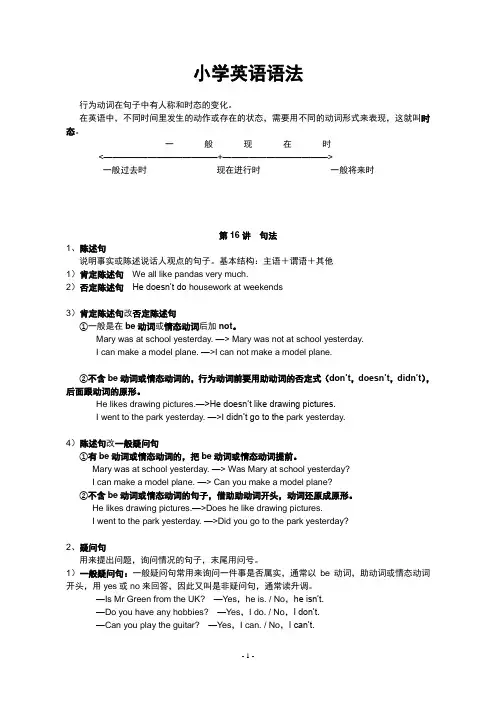
小学英语语法行为动词在句子中有人称和时态的变化。
在英语中,不同时间里发生的动作或存在的状态,需要用不同的动词形式来表现,这就叫时态。
一般现在时<—————————————+————————————>一般过去时现在进行时一般将来时第16讲句法1、陈述句说明事实或陈述说话人观点的句子。
基本结构:主语+谓语+其他1)肯定陈述句We all like pandas very much.2)否定陈述句He doesn’t do housework at weekends3)肯定陈述句改否定陈述句①一般是在be动词或情态动词后加not。
Mary was at school yesterday. —> Mary was not at school yesterday.I can make a model plane. —>I can not make a model plane.②不含be动词或情态动词的,行为动词前要用助动词的否定式(do n’t,doesn’t,didn’t),后面跟动词的原形。
He likes drawing pictures.—>He doesn’t like drawing pictures.I went to the park yesterday. —>I didn’t go to the park yesterday.4)陈述句改一般疑问句①有be动词或情态动词的,把be动词或情态动词提前。
Mary was at school yesterday. —> Was Mary at school yesterday?I can make a model plane. —> Can you make a model plane?②不含be动词或情态动词的句子,借助助动词开头,动词还原成原形。
He likes drawing pictures.—>Does he like drawing pictures.I went to the park yesterday. —>Did you go to the park yesterday?2、疑问句用来提出问题,询问情况的句子,末尾用问号。
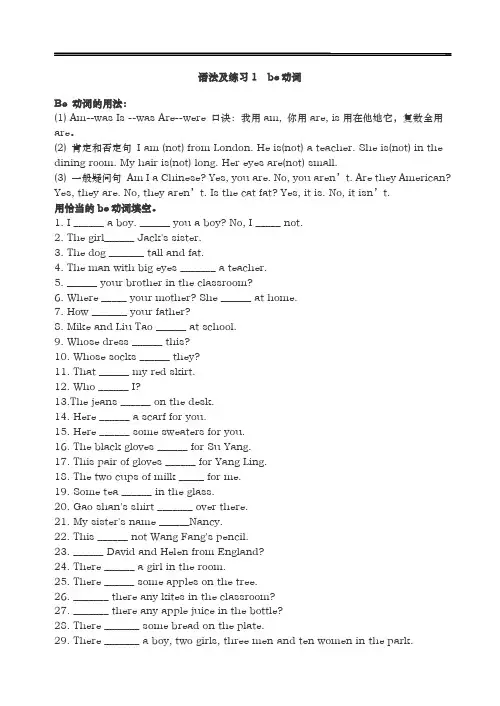
语法及练习1 be动词Be 动词的用法:(1) Am--was Is --was Are--were 口诀:我用am, 你用are, is用在他她它,复数全用are。
(2) 肯定和否定句I am (not) from London. He is(not) a teacher. She is(not) in the dining room. My hair is(not) long. Her eyes are(not) small.(3) 一般疑问句Am I a Chinese? Yes, you are. No, you aren’t. Are they American? Yes, they are. No, they aren’t. Is the cat fat? Yes, it is. No, it isn’t.用恰当的be动词填空。
1. I ______ a boy. ______ you a boy? No, I _____ not.2. The girl______ Jack's sister.3. The dog _______ tall and fat.4. The man with big eyes _______ a teacher.5. ______ your brother in the classroom?6. Where _____ your mother? She ______ at home.7. How _______ your father?8. Mike and Liu Tao ______ at school.9. Whose dress ______ this?10. Whose socks ______ they?11. That ______ my red skirt.12. Who ______ I?13.The jeans ______ on the desk.14. Here ______ a scarf for you.15. Here ______ some sweaters for you.16. The black gloves ______ for Su Yang.17. This pair of gloves ______ for Yang Ling.18. The two cups of milk _____ for me.19. Some tea ______ in the glass.20. Gao shan's shirt _______ over there.21. My sister's name ______Nancy.22. This ______ not Wang Fang's pencil.23. ______ David and Helen from England?24. There ______ a girl in the room.25. There ______ some apples on the tree.26. _______ there any kites in the classroom?27. _______ there any apple juice in the bottle?28. There _______ some bread on the plate.29. There _______ a boy, two girls, three men and ten women in the park.30. You, he and I ______ from China.语法及练习2 人称代词和物主代词人称代词和物主代词1.人称代词主格和宾格的区别:主格通常位于句中第一个动词之前(有时候位于than 之后),宾格一般位于动词或介词之后。

实用文档牛津英语小学基础语法大全任务:1、口头练习 2、填入相应的人称代词。
3A(M1U4—M2U1中间)be动词一、定义:英语中的be动词就是汉语中的“是”。
二、(举例)1、I am a teacher. 我是一名教师。
2、You are a student. 你是一名学生。
3、He is a boy. 他是一个男孩。
4、She is a girl. 她是一个女孩。
5、It is a bird. 它是一只小鸟。
6、We are friends. 我们是朋友。
7、You are friends. 你们是朋友。
8、They are friends. 他(她它)们是朋友。
引出分类:is, am, are三、口诀:我用am,你用are,is跟着他她它,男他,女她,动物它,要问复数用什么,一律使用一个are。
四、缩写:I am = I'm It is =It'sYou are = You're We are = We'reHe is = He's You are = You'reShe is = She's They are = They're五、习题。
1、I _____ a student. 7、What _____ your name?2、He _____ a boy. 8、I _____ fine.3、Kitty _____ a cat. 9、We _____ girls.4、How _____ you? 10、You _____ Lucy.5、They _____ desks. 11、Ben _____ ten.6、It _____ a book. 12、实用文档The apple _____ on the tree.17 、You _____ very late. 、13Miss Wang _____ a teacher. 14、It _____ yellow.18、I _____ here. 15、They _____ red.19、Spotty _____ 16、a dog.Alice and Peter _____ students. 20、She _____ grandma.3A M2U2be动词引导的陈述句1、定义:陈述一项事实的句子。

小学牛津英语语法大全第1讲字母......................... ................................................. (01)第2讲语音......................... ................................................. . (06)第3讲名词......................... ................................................. . (07)第4讲冠词......................... ................................................. (09)第5讲代词......................... ................................................. (10)第6讲形容词......................................................................... . (12)第7讲副词......................... ................................................. (13)第8讲介词......................... ................................................. (13)第9讲数词......................... ................................................. (15)第10讲连词......................... ................................................. (16)第11讲动词......................... ................................................. (17)第12讲一般现在时................................................................ (18)第13讲现在进行时................................................................ .. (19)第14讲一般过去时................................................................ .. (19)第15讲一般将来时................................................................ .. (20)第16讲句法......................................................................... . (21)第17讲听力......................... ................................................. . (23)第18讲话题......................... ................................................. . (24)第19讲构词法...................................................................... .. (26)第20讲英美文化识............................................................. . (27)第1讲字母1. 英语中共有26个字母。
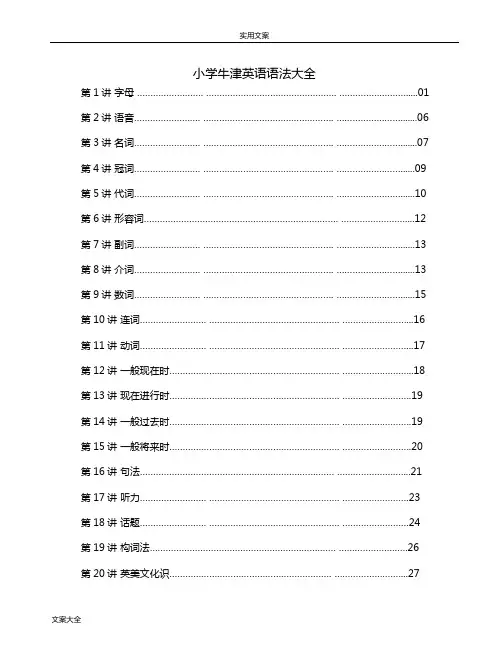
小学牛津英语语法大全第1讲字母......................... ................................................. (01)第2讲语音......................... ................................................. . (06)第3讲名词......................... ................................................. . (07)第4讲冠词......................... ................................................. (09)第5讲代词......................... ................................................. (10)第6讲形容词......................................................................... . (12)第7讲副词......................... ................................................. (13)第8讲介词......................... ................................................. (13)第9讲数词......................... ................................................. (15)第10讲连词......................... ................................................. (16)第11讲动词......................... ................................................. (17)第12讲一般现在时................................................................ (18)第13讲现在进行时................................................................ .. (19)第14讲一般过去时................................................................ .. (19)第15讲一般将来时................................................................ .. (20)第16讲句法......................................................................... . (21)第17讲听力......................... ................................................. . (23)第18讲话题......................... ................................................. . (24)第19讲构词法...................................................................... .. (26)第20讲英美文化识............................................................. . (27)第1讲字母1. 英语中共有26个字母。
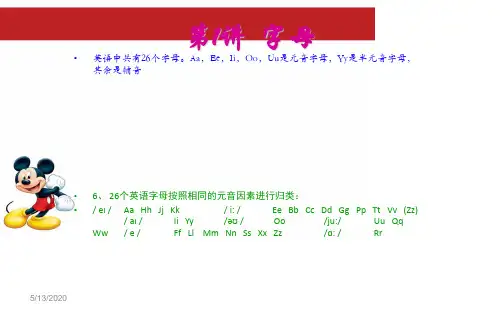
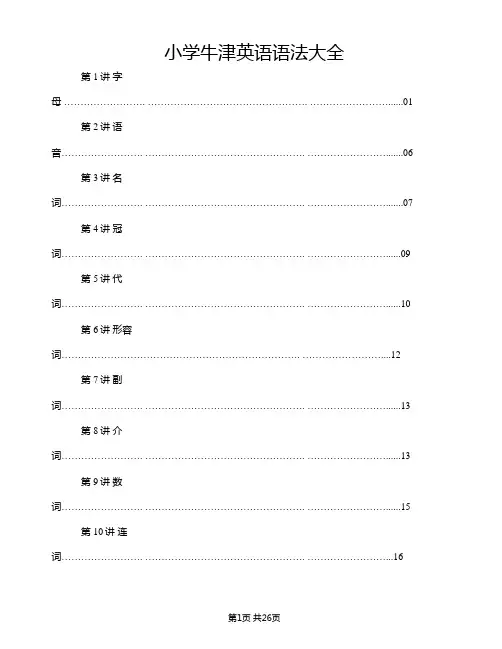
小学牛津英语语法大全第1讲字母......................... ................................................. (01)第2讲语音......................... ................................................. . (06)第3讲名词......................... ................................................. . (07)第4讲冠词......................... ................................................. (09)第5讲代词......................... ................................................. (10)第6讲形容词......................................................................... . (12)第7讲副词......................... ................................................. (13)第8讲介词......................... ................................................. (13)第9讲数词......................... ................................................. (15)第10讲连词......................... ................................................. (16)第11讲动词......................... ................................................. (17)第12讲一般现在时................................................................ (18)第13讲现在进行时................................................................ .. (19)第14讲一般过去时................................................................ .. (19)第15讲一般将来时................................................................ .. (20)第16讲句法......................................................................... . (21)第17讲听力......................... ................................................. . (23)第18讲话题......................... ................................................. . (24)第19讲构词法...................................................................... .. (26)第20讲英美文化识............................................................. . (27)第1讲字母1. 英语中共有26个字母。
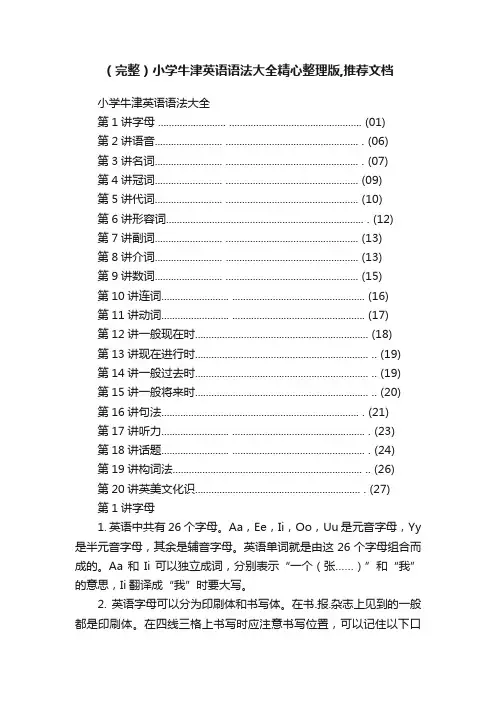
(完整)小学牛津英语语法大全精心整理版,推荐文档小学牛津英语语法大全第1讲字母 ......................... . (01)第2讲语音......................... ................................................. . (06)第3讲名词......................... ................................................. . (07)第4讲冠词......................... . (09)第5讲代词......................... . (10)第6讲形容词......................................................................... . (12)第7讲副词......................... . (13)第8讲介词......................... . (13)第9讲数词......................... . (15)第10讲连词......................... . (16)第11讲动词......................... . (17)第12讲一般现在时 (18)第13讲现在进行时................................................................ .. (19)第14讲一般过去时................................................................ .. (19)第15讲一般将来时................................................................ .. (20)第16讲句法......................................................................... . (21)第17讲听力......................... ................................................. . (23)第18讲话题......................... ................................................. . (24)第19讲构词法...................................................................... .. (26)第20讲英美文化识............................................................. . (27)第1讲字母1. 英语中共有26个字母。

语法及练习1 be动词Be 动词的用法:(1) Am--was Is --was Are--were 口诀:我用am, 你用are, is用在他她它,复数全用are。
(2) 肯定和否定句 I am (not) from London. He is(not) a teacher. She is(not) in the dining room. My hair is(not) long. Her eyes are(not) small.(3) 一般疑问句Am I a Chinese? Yes, you are. No, you aren’t. Are they American? Yes, they are. No, they aren’t. Is the cat fat? Yes, it is. No, it isn’t.用恰当的be动词填空。
1. I ______ a boy. ______ you a boy? No, I _____ not.2. The girl______ Jack's sister.3. The dog _______ tall and fat.4. The man with big eyes _______ a teacher.5. ______ your brother in the classroom?6. Where _____ your mother? She ______ at home.7. How _______ your father?8. Mike and Liu Tao ______ at school.9. Whose dress ______ this?10. Whose socks ______ they?11. That ______ my red skirt.12. Who ______ I?13.The jeans ______ on the desk.14. Here ______ a scarf for you.15. Here ______ some sweaters for you.16. The black gloves ______ for Su Yang.17. This pair of gloves ______ for Yang Ling.18. The two cups of milk _____ for me.19. Some tea ______ in the glass.20. Gao shan's shirt _______ over there.21. My sister's name ______Nancy.22. This ______ not Wang Fang's pencil.23. ______ David and Helen from England?24. There ______ a girl in the room.25. There ______ some apples on the tree.26. _______ there any kites in the classroom?27. _______ there any apple juice in the bottle?28. There _______ some bread on the plate.29. There _______ a boy, two girls, three men and ten women in the park.30. You, he and I ______ from China.语法及练习2 人称代词和物主代词人称代词和物主代词1.人称代词主格和宾格的区别:主格通常位于句中第一个动词之前(有时候位于than 之后),宾格一般位于动词或介词之后。
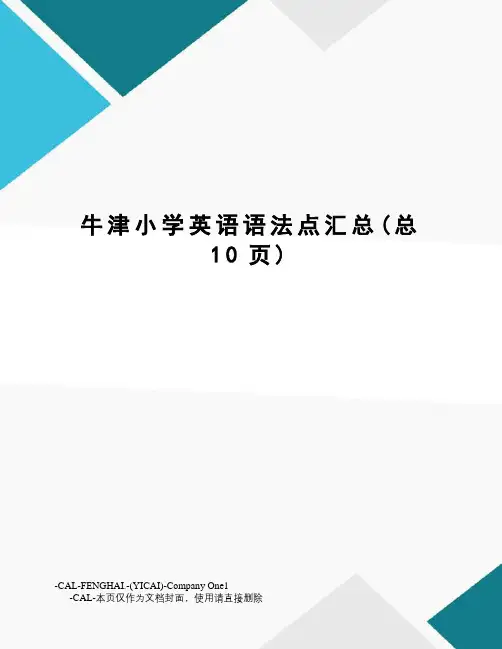
牛津小学英语语法点汇总(总10页)-CAL-FENGHAI.-(YICAI)-Company One1-CAL-本页仅作为文档封面,使用请直接删除语法及练习1 be动词Be 动词的用法:(1) Am--was Is --was Are--were 口诀:我用am, 你用are, is用在他她它,复数全用are。
(2) 肯定和否定句 I am (not) from London. He is(not) a teacher. She is(not) in the dining room. My hair is(not) long. Her eyes are(not) small.(3) 一般疑问句Am I a Chinese Yes, you are. No, you aren’t. Are they American Yes, they are. No, they aren’t. Is the cat fat Yes, it is. No, it isn’t.用恰当的be动词填空。
1. I ______ a boy. ______ you a boy No, I _____ not.2. The girl______ Jack's sister.3. The dog _______ tall and fat.4. The man with big eyes _______ a teacher.5. ______ your brother in the classroom6. Where _____ your mother She ______ at home.7. How _______ your father8. Mike and Liu Tao ______ at school.9. Whose dress ______ this10. Whose socks ______ they11. That ______ my red skirt.12. Who ______ I13.The jeans ______ on the desk.14. Here ______ a scarf for you.15. Here ______ some sweaters for you.16. The black gloves ______ for Su Yang.17. This pair of gloves ______ for Yang Ling.18. The two cups of milk _____ for me.19. Some tea ______ in the glass.20. Gao shan's shirt _______ over there.21. My sister's name ______Nancy.22. This ______ not Wang Fang's pencil.23. ______ David and Helen from England24. There ______ a girl in the room.25. There ______ some apples on the tree.`26. _______ there any kites in the classroom27. _______ there any apple juice in the bottle28. There _______ some bread on the plate.29. There _______ a boy, two girls, three men and ten women in the park.30. You, he and I ______ from China.语法及练习2 人称代词和物主代词人称代词和物主代词1.人称代词主格和宾格的区别:主格通常位于句中第一个动词之前(有时候位于than 之后),宾格一般位于动词或介词之后。
小学牛津英语语法大全第1讲字母......................... ................................................. (01)第2讲语音......................... ................................................. . (06)第3讲名词......................... ................................................. . (07)第4讲冠词......................... ................................................. (09)第5讲代词......................... ................................................. (10)第6讲形容词......................................................................... . (12)第7讲副词......................... ................................................. (13)第8讲介词......................... ................................................. (13)第9讲数词......................... ................................................. (15)第10讲连词......................... ................................................. (16)第11讲动词......................... ................................................. (17)第12讲一般现在时................................................................ (18)第13讲现在进行时................................................................ .. (19)第14讲一般过去时................................................................ .. (19)第15讲一般将来时................................................................ .. (20)第16讲句法......................................................................... . (21)第17讲听力......................... ................................................. . (23)第18讲话题......................... ................................................. . (24)第19讲构词法...................................................................... .. (26)第20讲英美文化识............................................................. . (27)第1讲字母1. 英语中共有26个字母。
Aa,Ee,Ii,Oo,Uu是元音字母,Yy是半元音字母,其余是辅音字母。
英语单词就是由这26个字母组合而成的。
Aa和Ii可以独立成词,分别表示“一个(张……)”和“我”的意思,Ii翻译成“我”时要大写。
2. 英语字母可以分为印刷体和书写体。
在书.报.杂志上见到的一般都是印刷体。
在四线三格上书写时应注意书写位置,可以记住以下口诀:大写字母不顶格,小写字母占满格。
书写时还要注意字母的笔顺。
3. 英语句子的第一个单词的首字母要大写。
单词与单词之间在书写时必须保持适当的距离,一般以空出一个小写字母的宽度为宜。
句子的末尾要有标点符号。
4. 英语中的句号是一个实心圆点(.),省略号是三个居下的实心圆点(…),英语中没有顿号和书名号,顿号用逗号替代,书名用斜体字表示。
5. 英语缩写词个英语字母按照相同的元音因素进行归类7.缩略词8.缩写式8.国家缩写第2讲语音1. 音素:语音的最小单位。
2. 元音:发音时气流不受阻碍。
元音分为单元音和双元音两类。
单元音发音时唇形和舌位不变;双元音发音时由一个元音向另一个元音滑动,唇形和舌位有一个变化过程,且前重后轻,前长后短。
3. 辅音:发音时气流受到阻碍。
辅音分为清辅音和浊辅音两类。
清辅音发音时声带不振动;浊辅音发音时声带振动。
4. 音标:用来记录音素的符号。
为了避免与字母混淆,音标被放在斜括号/ /内。
5. 英语中的一个字母或字母组合在不同的单词中发音可能是不一样的,而相同的发音对应的字母或字母组合也可能不完全相同。
6. 开音节:以元音字母结尾或以一个元音字母加一个辅音字母再加不发音的e结尾(r除外)的音节。
元音字母在开音节中读长音,即该字母的名称音。
闭音节:以一个或几个辅音字母(r除外)结尾。
元音字母在闭音节中读短音。
第3讲名词名词是指表示人和事物名称的词,可以分为专有名词和普通名词两大类。
1. 专有名词:特定的人.地方.机构等专有的名称。
第一个字母通常要大写。
. Jim Green, New York, Bank of China,Peking University星期.月份.节日.学科.报刊名也是专有名词。
. Monday,May,Christmas,Spring Festival,Maths,China Daily2. 普通名词:表示一类人或物或抽象概念的名称。
普通名词又可以分为四类:个体名词——表示某类人或东西中的个体,如:student , desk集体名词——表示若干个体组成的集合体,如:class , family物质名词——表示无法分为个体的物质名称,如:water , rice , sand,hair抽象名词——表示情感,状态,品质等抽象名称,如:love ,carelessness个体名词和集体名词多数可以用数目来计算,称为可数名词,有单.复数形式;物质名词和抽象名词通常无法用数目计算,称为不可数名词,一般只有一种形式。
注意:① 集体名词被看作一个整体时,表达单数概念。
. His family was well known in the town. 他家在镇里是名门望族。
② 集体名词被看作若干个体的集合时,表达复数概念。
.His family are waiting for him.她的家人正在等他③ 集体名词表达多个集体时,也有复数形式。
.Our village is made up of300families.我们村有300户人家。
3.可数名词复数形式的构成规则:① 一般名词在末尾直接加s,清辅音后读/ s /,浊辅音和元音后读/ z /. book-books, bag-bags, cat-cats, bed-beds② 以结尾,加es,读/ IZ /. bus-buses, box-boxes,brush-brushes,watch-watches③ 以辅音字母+y结尾,变y为i,再加es,读/ z /. baby-babies, library-libraries,factory-factories④ 以f或fe结尾,变f或fe为v,再加es,读/ vz /. thief-thieves,knife-knives⑤ 以o结尾,表示无生命的物体时加s, 表示有生命的物体时,加es,都读/ z /. photo-photos, piano-pianos, radio-radios, zoo-zoospotato-potatoes,tomato-tomatoes,mango-mangoes,hero-heroes⑥ 不规则变化. man-men woman-women policeman-policemenchild-children mouse-mice ox-oxenfoot-feet tooth-teeth goose-geesefish-fish sheep-sheep deer-deer▲ fish表示鱼的数量时,单复数同形;表示鱼的种类时,复数为fishes.4. 不可数名词一般只有原形,没有复数形式,但是可以借助量词表示一定的数量。
如果表达两个或两个以上的概念时,量词需要用复数形式,不可数名词不变。
. a bottle of water ,a cup of coffee,two glasses of milk ,five bags of rice▲ 这种形式用于可数名词时,量词和可数名词都要用复数。
. ten baskets of eggs5. 既可用作可数,又可用作不可数的名词:不可数可数glass 玻璃 a glass 一只玻璃杯paper 纸 a paper 一份报纸.论文.文件iron 铁 a iron 一个熨斗wood 木头 a wood 一片森林beauty 美 a beauty 一个美人room 空间 a room 一个房间6. 名词所有格① 在英语中,有些名词可以加’s来表示所有关系,带这种词尾的名词形式称为该名词的所有格。
大多数表示有生命的东西。
. Tom's book② 如果复数名词末尾已有s,就直接加’。
. the teachers' office③ 如果一些物品为两者共有,只需在后一个名词后加’s ;如果为各自所有,则需在每个名词后加’s。
. Lucy and Lily's bedroom.(Lucy 和 Lily共用一个卧室)Lucy's and Lily's bedrooms.(Lucy 和 Lily分别拥有各自的卧室)④ 表示无生命的物体的名词所有格,一般与of短语连用。